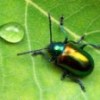
Deserts are difficult places to live for more reasons than just drought and heat. During dry seasons deserts are relatively inactive, and there's not much around for animals to eat. To survive times of dearth, several lineages of desert ants have taken to harvesting plant seeds in the brief periods of bounty that follow rains. If stored properly, grains keep for years and can provide the colony with ample resources during times when the deserts are dry.
This past week the stubby carpet of spring grasses in our normally barren back yard started going to seed. After months of dormancy, our resident colony of Pogonomyrmex desertorum harvester ants has sprung to life, sending forth armies of workers to gather the riches. I spent a few hours this weekend shooting the ants as they clambered about in the grass stalks, cutting down the seeds and hauling them back to their nest.

An ant's-eye view of the golden fields of bounty behind our house.

The harvesters' nest is marked by an inconspicuous hole surrounded by bits of discarded seed husks.

A worker leaves the nest to gather seeds.

Scaling seed stalks to cut free the harvest.





Heading home with a seed.

Out front, two different species of seed harvesters are also active. The big bruiser of the harvester ant world is the rough harvester Pogonomyrmex rugosus.

Our other harvester is not so easy to notice. We have a nest of the delicate Pheidole xerophila - a miniature harvester only 3mm long that feeds on small seeds. This and several other Pheidole species have evolved granivory independently of the big Pogonomyrmex.

Beautiful pictures, the acrobatic ant on the stalks are really well done.
fantastic! I'll share this with the kids we work with on an urban farm project- cause we look forward to the harvest as well! thanks for your beautiful documentation. linda
What a nice little photoessay of this ant! Your pictures are always so sharp and you capture their behaviors so well.
Thanks guys!
My husband and I were talking this morning about the habits of an ant. This was such a wonderful example of work habits we can learn form. Our whole family enjoyed your pic's.
Thank you for sharing!